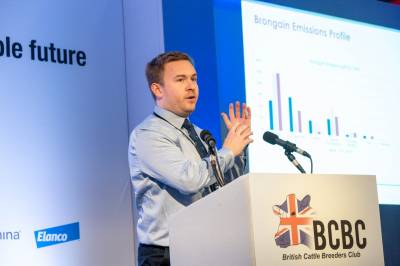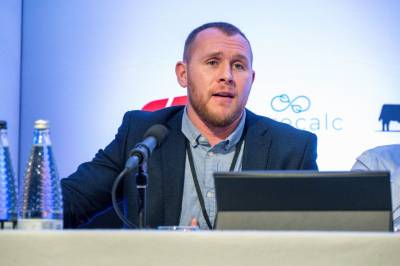

Brongain Farms are using data to pinpoint areas for improvement in its quest to become carbon neutral by 2030.
Father and son Rowan and Greg Pickstock, who are also beef processors, farm 350ha in Llanfechain.
They are targeting a daily liveweight gain of 1.1kg to produce net zero beef from grass.
Currently, dairy-beef animals are finished at 650kg aged 22.5 months, and are on grass for 270 days, with a target to reduce slaughter age to 20 months.
About their system
They source heifer and steer calves from nearby dairy farms. Calves are fed on automatic machines and are weaned onto a straw and concentrate diet at 10 weeks. They then transition to a forage-based TMR by four months of age.
In recent years, more emphasis has been placed on grazing to reduce costs.
Animals are rotationally grazed for 250-270 days of their life from six months of age in mobs of 150 head, typically from early March to late November.
During the winter, cattle are housed and fed a forage-based TMR of grass silage and barley, or protein blend, when necessary.
For the final 60-day finishing period, cattle are fed a silage-based TMR supplemented with 5kg rolled barley.
Grassland improvements
Since incorporating herbal leys and clovers into their grassland swards, they now use no artificial nitrogen on the 160-ha grazing platform, instead using digestate from the abattoir.
“The focus over the last three years has been to improve forage quality. Over the last two seasons, they have switched from a two-cut system to multi-cut silage system. This has led to greater animal performance and reduced bought in protein which is helping meet our carbon aspirations,” explained Brongain nutritionist Iwan Vaughan, from Dairy Diagnosis.
They are using Bokashi to ferment manure anaerobically. This has retained 11% more nitrogen, 56% more carbon and reduced emissions by 2.6% within the first year it was implemented, with its effect on emissions in subsequent years being routinely measured and validated.
Alongside this, they have integrated clover and multi-species into grass and use remedial-only tillage.
Using mixed swards was seen as an integral part of meeting carbon demands and improving soil health but it has also helped lift grass production from 7t DM/ha to 10-11t DM/ha, explained Mr Vaughan.
Animal health
Animal health has been another big focus area for the Brongain team with weight data showing pneumonia significantly increases days to slaughter.
“Over the last couple of years, we have made ventilation changes to the shed and implemented strategic vaccination programmes,” said Mr Vaughan.
Genetics
Mr Peart said that ‘genetics underpinned each of the key areas of efficiency gains needed to hit net zero’.
They work with dairy farmers to select sires for calving ease and growth rate using Genus ABS Nuera Profit Index.
“On the dairy farm we procure the calves from, we want zero-calving intervention because of the associated growth rate drop, pneumonia risk and other health risks that come with that,” explained George Peart, sustainability lead for Promar and advisor to Brongain.
Cattle are weighed monthly, and a large proportion of calves are genomic tested to match sire with health risk, finishing time and carcase quality.
Farm facts:
- Farming 350 hectares of permanent pasture.
- Finishing 800 Angus x dairy calves/year.
- They have planted 5,000 trees on non-productive areas, increasing tree cover from 5 to 8.5% to improve carbon sequestration.
- They have invested in more bedding to reduce lameness, which has contributed to improved finishing times and a reduction in enteric emissions.
Future
The team at Brongain now plans to delve deeper into ranking animals individually. They will start measuring gross energy intake from forage and activity tracking animals to assess how much energy is going toward growth versus maintenance and establish the variation in feed conversion, even at pasture.
“In the future, if we can select for specific rumen microbiome and the associate methane drop, this is something we will be diving on very quickly,” said Mr Peart.
George Peart and Iwan Vaughan were presenting on behalf of Brongain Farms at the BCBC conference in January